Mass Variations in Terrestrial Water Storage over the Nile River Basin and Mega Aquifer System as Deduced from GRACE-FO Level-2 Products and Precipitation Patterns from GPCP Data
Abstract
:1. Introduction
2. GRACE-FO Level-2 Products and Precipitation Data
3. Methodology
4. Results and Discussion
5. Conclusions
Author Contributions
Funding
Acknowledgments
Conflicts of Interest
Abbreviations
| AAP | Average Annual Precipitation |
| AMP | Average Monthly Precipitation |
| CSR | the Center for Space Research (University of Texas in Austin) |
| DDK | Decorrelation filter |
| EWH | Equivalent Water Heights |
| GFZ | GeoForschungsZentrum (the German Center forGeosciences), Potsdam |
| GPCP | Global Precipitation Climatology Project |
| GRACE | Gravity Recovery And Climate Experiment |
| GRACE-FO | Gravity Recovery And Climate Experiment Follow-On |
| JPL | Jet Propulsion Laboratory |
| MAS | Aquifer System |
| NRB | Nile River Basin |
| RL06 | ReLease number 06 |
| SHC | Spherical Harmonic Coefficients |
| SDS | Science Data System |
| TWS | Total Water Storage |
References
- Trenberth, K.E.; Dai, A.; Rasmussen, R.M.; Parsons, D.B. The changing character of precipitation. Bull. Am. Meteorol. Soc. 2003, 84, 1205–1218. [Google Scholar] [CrossRef]
- Watterson, I.G.; Dix, M.R. Simulated changes due to global warming in daily precipitation means and extremes and their interpretation using the gamma distribution. J. Geophys. Res. Atmos. 2003, 108, 4379. [Google Scholar] [CrossRef]
- Sun, Y.; Solomon, S.; Dai, A.; Portmann, R.W. How often will it rain? J. Clim. 2007, 20, 4801–4818. [Google Scholar] [CrossRef]
- Trenberth, K.E. Changes in precipitation with climate change. Clim. Res. 2011, 47, 123–138. [Google Scholar] [CrossRef] [Green Version]
- Lau, W.K.M.; Wu, H.T.; Kim, K.M. A canonical response of precipitation characteristics to global warming from CMIP5 models. Geophys. Res. Lett. 2013, 40, 3163–3169. [Google Scholar] [CrossRef]
- Westra, S.; Fowler, H.J.; Evans, J.P.; Alexander, L.V.; Berg, P.; Johnson, F.; Kendon, E.J.; Lenderink, G.; Roberts, N.M. Future changes to the intensity and frequency of short-duration extreme rainfall. Rev. Geophys. 2014, 52, 522–555. [Google Scholar] [CrossRef] [Green Version]
- Donat, M.G.; Lowry, A.L.; Alexander, L.V.; O’Gorman, P.A.; Maher, N. More extreme precipitation in the world’s dry and wet regions. Nat. Clim. Chang. 2016, 6, 508–513. [Google Scholar] [CrossRef]
- Dai, A.; Rasmussen, R.M.; Liu, C.; Ikeda, K.; Prein, A.F. A new mechanism for warm-season precipitation response to global warming based on convection-permitting simulations. Clim. Dyn. 2020, 55, 343–368. [Google Scholar] [CrossRef]
- Abdelmohsen, K.; Sultan, M.; Ahmed, M.; Save, H.; Elkaliouby, B.; Emil, M.; Yan, E.; Abotalib, A.Z.; Krishnamurthy, R.V.; Abdelmalik, K. Response of deep aquifers to climate variability. Sci. Total Environ. 2019, 677, 530–544. [Google Scholar] [CrossRef]
- Abdelmohsen, K.; Sultan, M.; Save, H.; Abotalib, A.Z.; Yan, E. What can the GRACE seasonal cycle tell us about lake-aquifer interactions? Earth-Sci. Rev. 2020, 211, 103392. [Google Scholar] [CrossRef]
- Sataer, G.; Sultan, M.; Emil, M.K.; Yellich, J.A.; Palaseanu-Lovejoy, M.; Becker, R.; Gebremichael, E.; Abdelmohsen, K. Remote Sensing Application for Landslide Detection, Monitoring along Eastern Lake Michigan (Miami Park, MI). Remote Sens. 2022, 14, 3474. [Google Scholar] [CrossRef]
- Hakimi, M.H.; Varfolomeev, M.A.; Kahal, A.Y.; Gharib, A.F.; Alshehri, F.; Rahim, A.; Al Faifi, H.J.; Al-Muntaser, A.A.; Qaysi, S.; Abdelmohsen, K. Conventional and unconventional petroleum potentials of the Late Jurassic Madbi organic-rich shales from the Sunah oilfield in the Say’un--Masilah Basin, Eastern Yemen. J. Asian Earth Sci. 2022, 231, 105221. [Google Scholar] [CrossRef]
- Izadi, M.; Sultan, M.; El Kadiri, R.; Ghannadi, A.; Abdelmohsen, K. A Remote Sensing and Machine Learning—Based Approach to Forecast the Onset of Harmful Algal Bloom. Remote Sens. 2021, 13, 3863. [Google Scholar] [CrossRef]
- Aljammaz, A.; Sultan, M.; Izadi, M.; Abotalib, A.Z.; Elhebiry, M.S.; Emil, M.K.; Abdelmohsen, K.; Saleh, M.; Becker, R. Land Subsidence Induced by Rapid Urbanization in Arid Environments: A Remote Sensing-Based Investigation. Remote Sens. 2021, 13, 1109. [Google Scholar] [CrossRef]
- Pankratz, H.G.; Sultan, M.; Abdelmohsen, K.; Sauck, W.A.; Alsefry, S.; Alharbi, H.; Emil, M.K.; Gebremichael, E.; Asaeidi, A.; Alshehri, F.; et al. Use of Geophysical and Radar Interferometric Techniques to Monitor Land Deformation Associated with the Jazan Salt Diapir, Jazan city, Saudi Arabia. Surv. Geophys. 2021, 42, 177–200. [Google Scholar] [CrossRef]
- AbouAly, N.; Abdelmohsen, K.; Becker, M.; Mohamed, A.-M.S.; Abotalib, A.Z.; Saleh, M.; Zahran, K.H. Evaluation of annual and semiannual total mass variation over the Mediterranean Sea from satellite data. Arab. J. Geosci. 2021, 14, 1–13. [Google Scholar] [CrossRef]
- Tapley, B.D.; Bettadpur, S.; Ries, J.C.; Thompson, P.F.; Watkins, M.M. GRACE Measurements of Mass Variability in the Earth System. Science 2004, 305, 503–505. [Google Scholar] [CrossRef] [Green Version]
- Ahmed, M.; Abdelmohsen, K. Quantifying modern recharge and depletion rates of the Nubian Aquifer in Egypt. Surv. Geophys. 2018, 39, 729–751. [Google Scholar] [CrossRef]
- Abdelmalik, K.W.; Abdelmohsen, K. GRACE and TRMM mission: The role of remote sensing techniques for monitoring spatio-temporal change in total water mass, Nile basin. J. Afr. Earth Sci. 2019, 160, 103596. [Google Scholar] [CrossRef]
- Sahour, H.; Sultan, M.; Abdellatif, B.; Emil, M.; Abotalib, A.Z.; Abdelmohsen, K.; Vazifedan, M.; Mohammad, A.T.; Hassan, S.M.; Metwalli, M.R.; et al. Identification of shallow groundwater in arid lands using multi-sensor remote sensing data and machine learning algorithms. J. Hydrol. 2022, 614, 128509. [Google Scholar] [CrossRef]
- Sultan, M.; Sturchio, N.C.; Alsefry, S.; Emil, M.K.; Ahmed, M.; Abdelmohsen, K.; AbuAbdullah, M.M.; Yan, E.; Save, H.; Alharbi, T.; et al. Assessment of age, origin, and sustainability of fossil aquifers: A geochemical and remote sensing–based approach. J. Hydrol. 2019, 576, 325–341. [Google Scholar] [CrossRef]
- Othman, A.; Sultan, M.; Becker, R.; Alsefry, S.; Alharbi, T.; Gebremichael, E.; Alharbi, H.; Abdelmohsen, K. Use of Geophysical and Remote Sensing Data for Assessment of Aquifer Depletion and Related Land Deformation. Surv. Geophys. 2018, 39, 543–566. [Google Scholar] [CrossRef] [PubMed] [Green Version]
- Othman, A.; Abdelmohsen, K. A Geophysical and Remote Sensing-Based Approach for Monitoring Land Subsidence in Saudi Arabia. In Applications of Space Techniques on the Natural Hazards in the MENA Region; Springer: Cham, Switzerland, 2022; pp. 477–494. [Google Scholar]
- Abdelmohsen, K.; Sultan, M.; Save, H.; Abotalib, A.Z.; Yan, E.; Zahran, K.H. Buffering the impacts of extreme climate variability in the highly engineered Tigris Euphrates river system. Sci. Rep. 2022, 12, 1–13. [Google Scholar] [CrossRef] [PubMed]
- Sahour, H.; Sultan, M.; Vazifedan, M.; Abdelmohsen, K.; Karki, S.; Yellich, J.A.; Gebremichael, E.; Alshehri, F.; Elbayoumi, T.M. Statistical Applications to Downscale GRACE-Derived Terrestrial Water Storage Data and to Fill Temporal Gaps. Remote Sens. 2020, 12, 533. [Google Scholar] [CrossRef] [Green Version]
- Flechtner, F. GFZ Level-2 Processing Standards Document for Level-2 Product Release 0003. GeoForschungszentrum Potsdam Geod. Remote Sens. 2005. Available online: https://gfzpublic.gfz-potsdam.de/rest/items/item_61197_3/component/file_61227/content (accessed on 10 October 2022).
- Watkins, M.M.; Wiese, D.N.; Yuan, D.-N.; Boening, C.; Landerer, F.W. Improved methods for observing Earth’s time variable mass distribution with GRACE using spherical cap mascons. J. Geophys. Res. Solid Earth 2015, 120, 2648–2671. [Google Scholar] [CrossRef]
- Save, H. CSR GRACE RL06 Mascon Solutions. Available online: https://dataverse.tdl.org/dataset.xhtml?persistentId=doi:10.18738/T8/UN91VR (accessed on 24 December 2019).
- Kusche, J.; Schrama, E.J.O. Surface mass redistribution inversion from global GPS deformation and Gravity Recovery and Climate Experiment (GRACE) gravity data. J. Geophys. Res. 2005, 110, B09409. [Google Scholar] [CrossRef] [Green Version]
- Aiazzi, B.; Alparone, L.; Baronti, S.; Garzelli, A. Context-driven fusion of high spatial and spectral resolution images based on oversampled multiresolution analysis. Ieee Trans. Geosci. Remote Sens. 2002, 40, 2300–2312. [Google Scholar] [CrossRef]
- Wahr, J.; Molenaar, M.; Bryan, F. Time variability of the Earth’s gravity field: Hydrological and oceanic effects and their possible detection using GRACE. J. Geophys. Res. 1998, 103, 30205–30229. [Google Scholar] [CrossRef]
- Jekeli, C. Alternative Methods to Smooth the Earth’s Gravity Field; Department of Civil and Environmental Engineering and Geodetic Science, Ohio State University: Columbus, OH, USA, 1981. [Google Scholar]
- Swenson, S.; Wahr, J. Estimating large-scale precipitation minus evapotranspiration from GRACE satellite gravity measurements. Geophys. Res. Lett. 2006, 7, 252–270. [Google Scholar] [CrossRef] [Green Version]
- Wouters, B.; Schrama, E.J.O. Improved accuracy of GRACE gravity solutions through empirical orthogonal function filtering of spherical harmonics. Geophys. Res. Lett. 2007, 34, L23711. [Google Scholar] [CrossRef]
- Kusche, J. Approximate decorrelation and non-isotropic smoothing of time-variable GRACE-type gravity field models. J. Geod. 2007, 81, 733–749. [Google Scholar] [CrossRef] [Green Version]
- Klees, R.; Zapreeva, E.A.; Winsemius, H.C.; Savenije, H.G. The bias in GRACE estimates of continental water storage variations. Hydrol. Earth Syst. Sci. 2007, 11, 1227–1241. [Google Scholar] [CrossRef] [Green Version]
- Kusche, J.; Schmidt, R.; Petrovic, S.; Rietbroek, R. Decorrelated GRACE time-variable gravity solutions by GFZ, and their validation using a hydrological model. J. Geod. 2009, 83, 903–913. [Google Scholar] [CrossRef] [Green Version]
- Elsaka, B.; El-Ashquer, M. Comparison between Gaussian and decorrelation filters of GRACE-based RL05 temporal gravity solutions over Egypt. Surv. Rev. 2021, 54, 233–242. [Google Scholar] [CrossRef]
- Adler, R.F.; Huffman, G.J.; Chang, A.; Ferraro, R.; Xie, P.-P.; Janowiak, J.; Rudolf, B.; Schneider, U.; Curtis, S.; Bolvin, D.; et al. The Version-2 Global Precipitation Climatology Project (GPCP) Monthly Precipitation Analysis (1979 Present). J. Hydrometeorol. 2003, 4, 1147. [Google Scholar] [CrossRef]
- Elsaka, B. Evaluation of Terrestrial Total Water Height Variations over the Nile River Basin Based on Two Full-Years of GRACE-FO Gravity Field Monthly Solutions. Int. Res. J. Adv. Eng. Sci. 2021, 6, 90–95. [Google Scholar]
- Hasan, E.; Tarhule, A.; Kirstetter, P.E. Twentieth and twenty-first century water storage changes in the nile river basin from grace/grace-fo and modeling. Remote Sens. 2021, 13, 953. [Google Scholar] [CrossRef]
- Ahmed, M.; Sultan, M.; Wahr, J.; Yan, E. The use of GRACE data to monitor natural and anthropogenic induced variations in water availability across Africa. Earth-Sci. Rev. 2014, 136, 289–300. [Google Scholar] [CrossRef]
- Wessel, P.; Smith, W.H.F.; Scharroo, R.; Luis, J.F.; Wobbe, F. Generic mapping tools: Improved version released. EOS Trans. AGU 2013, 94, 409–410. [Google Scholar] [CrossRef]
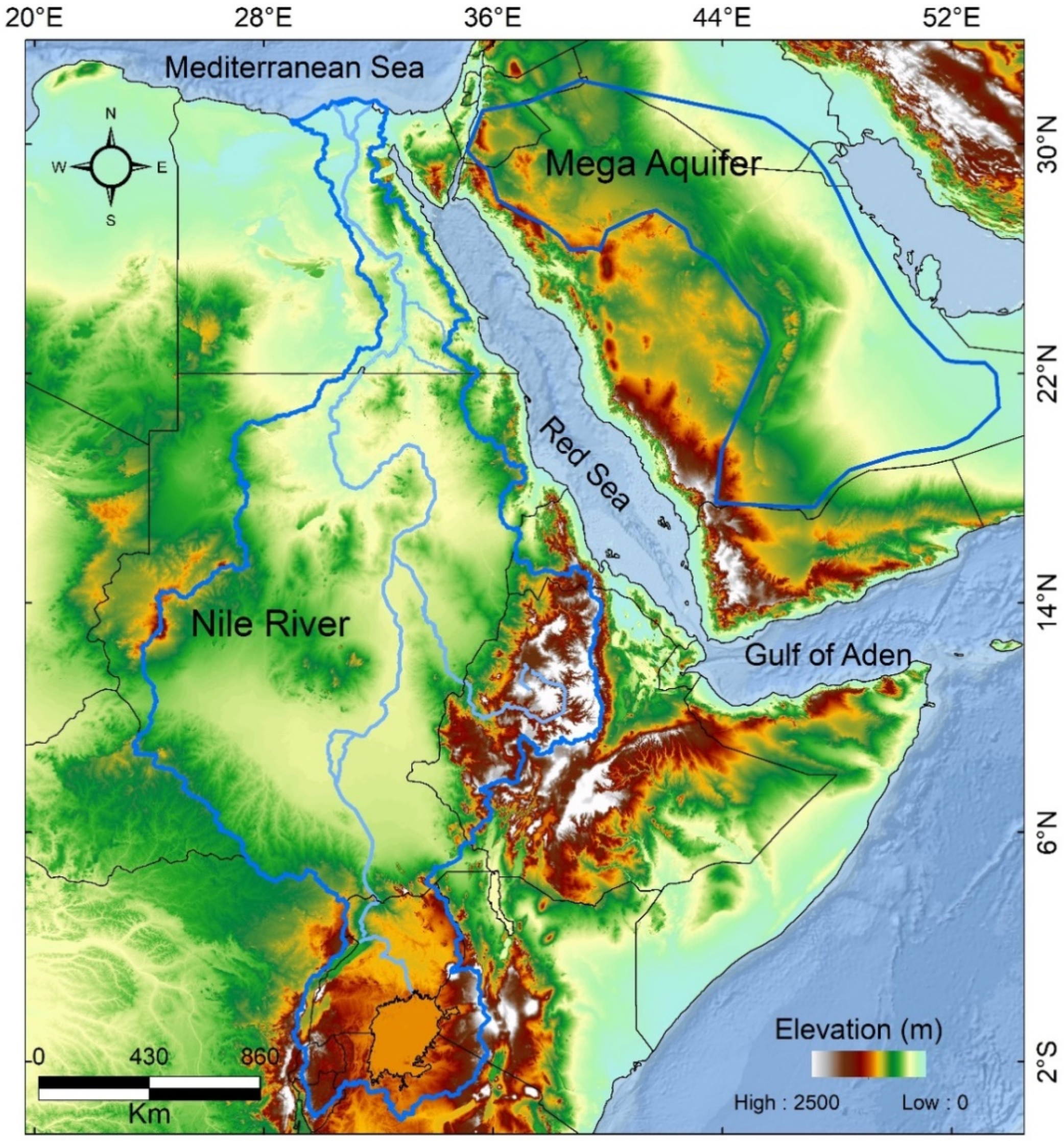
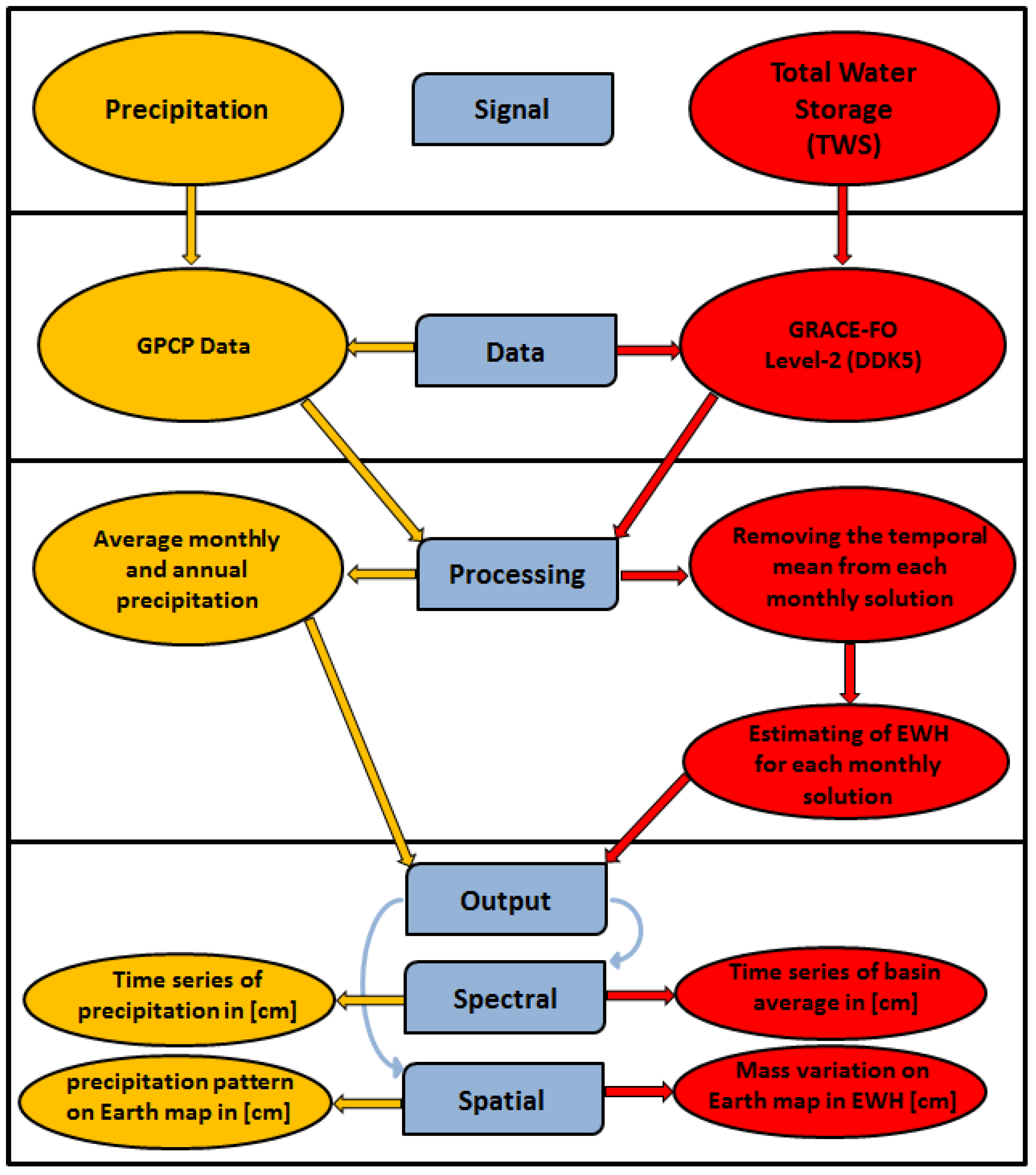
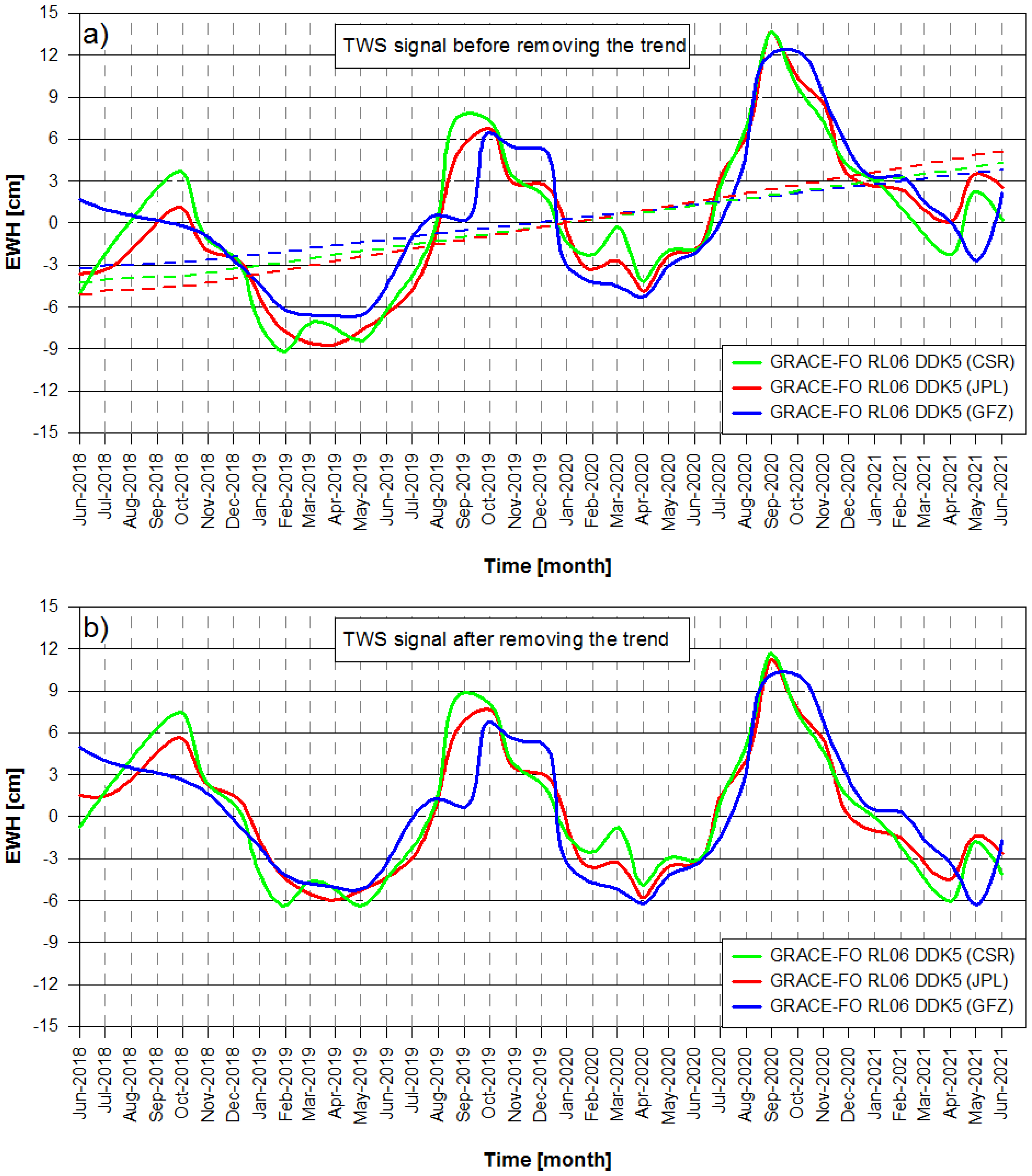
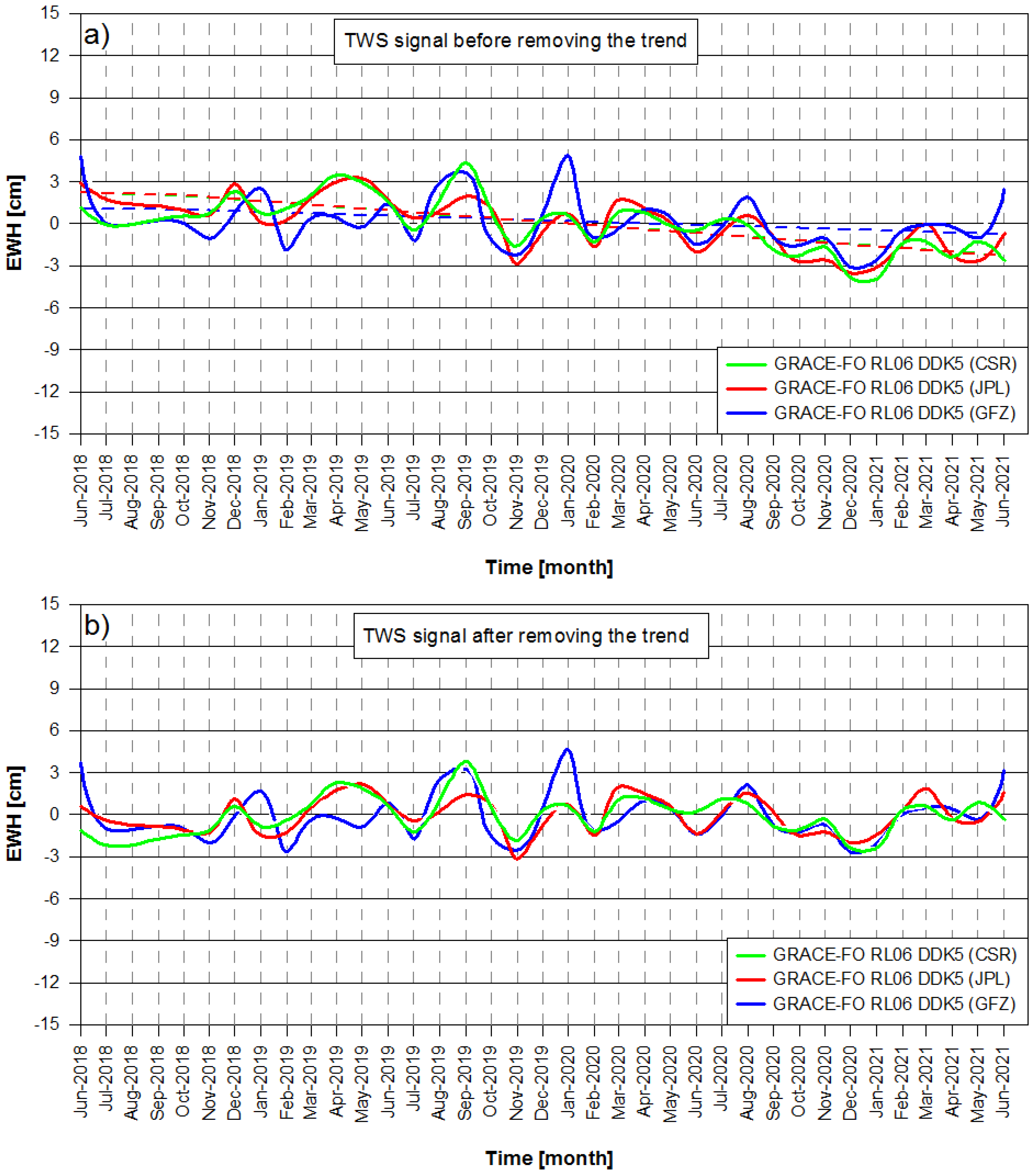
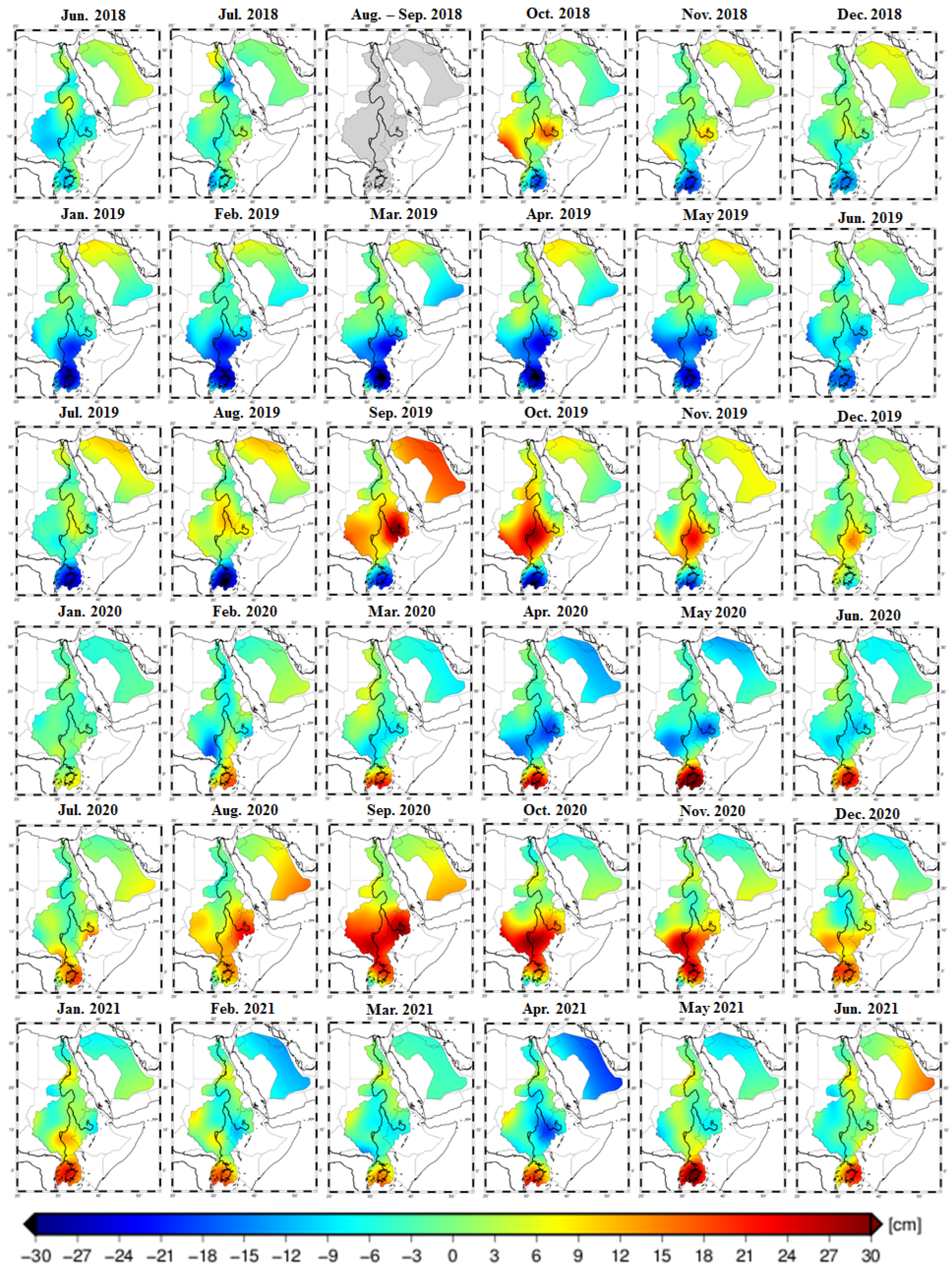
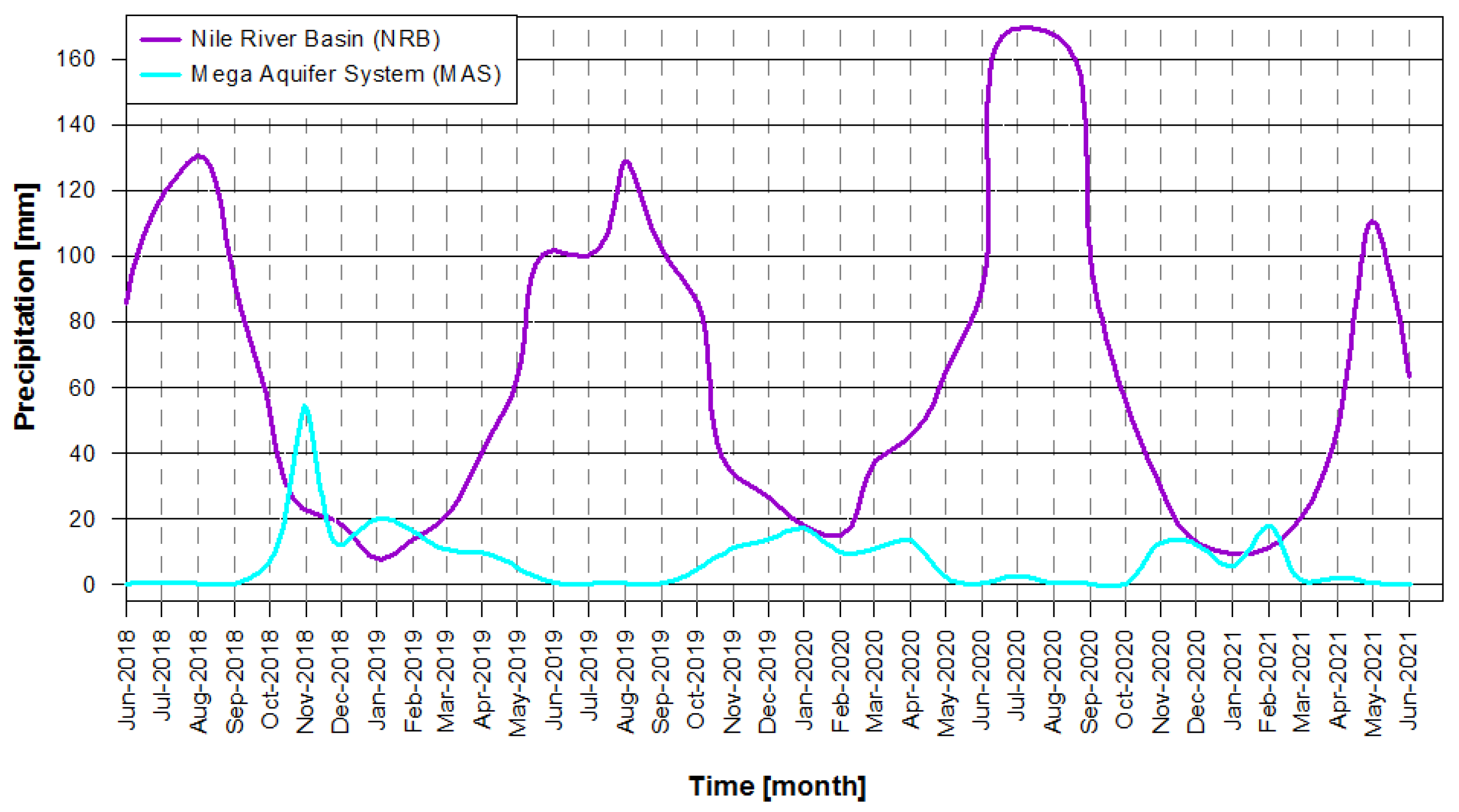
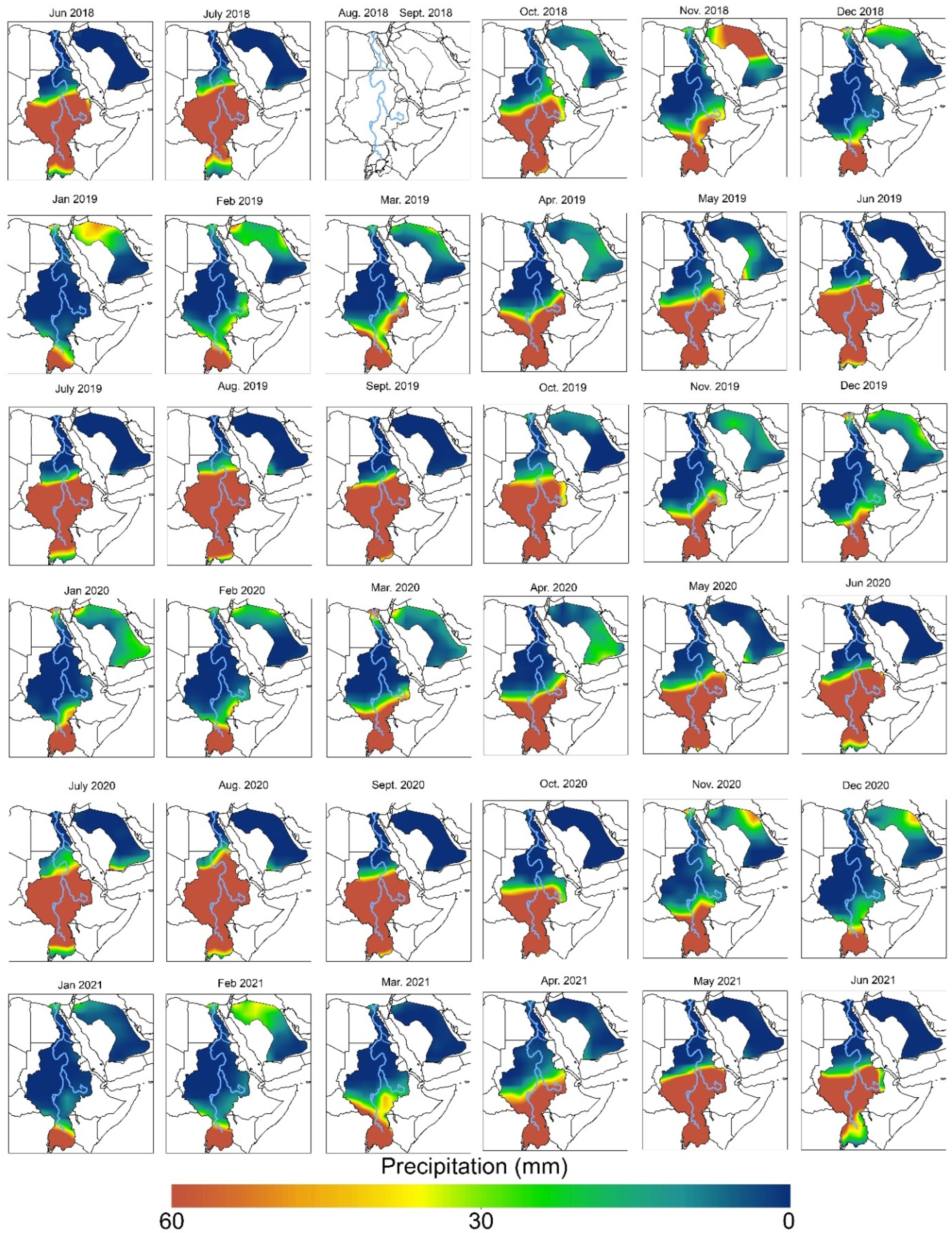
| Months of Year | NILE River Basin | Mega Aquifer | ||||||
|---|---|---|---|---|---|---|---|---|
| TWS [cm] | Precipitation [cm] | TWS [cm] | Precipitation [cm] | |||||
| GFZ | CSR | JPL | GFZ | CSR | JPL | |||
| 2018-06 | 1.686 | −5,066 | −3.612 | 8.567 | 4.826 | 1.153 | 2.891 | 0.029 |
| 2018-07 | 0.987 | −2,240 | −3.392 | 11.76 | 0.063 | −0.069 | 1.761 | 0.061 |
| 2018-08 | --- | --- | --- | 13.04 | --- | --- | --- | 0.036 |
| 2018-09 | --- | --- | --- | 9.176 | --- | --- | --- | 0.021 |
| 2018-10 | −0.201 | 3.642 | 1.079 | 5.365 | 0.021 | 0.550 | 0.946 | 0.690 |
| 2018-11 | −1.000 | −1.254 | −2.023 | 2.258 | −1.053 | 0.745 | 0.610 | 5.466 |
| 2018-12 | −2.641 | −2.339 | −2.419 | 1.870 | 0.807 | 2.324 | 2.880 | 1.217 |
| 2019-01 | −4.373 | −7.204 | −5.343 | 0.741 | 2.518 | 0.748 | 0.116 | 1.993 |
| 2019-02 | −6.251 | −9.153 | −7.786 | 1.361 | −1.900 | 1.089 | 0.239 | 1.609 |
| 2019-03 | −6.581 | −7.143 | −8.551 | 2.074 | 0.368 | 2.031 | 1.836 | 1.054 |
| 2019-04 | −6.631 | −7.501 | −8.695 | 4.061 | 0.442 | 3.490 | 2.966 | 0.976 |
| 2019-05 | −6.587 | −8.410 | −7.711 | 6.287 | −0.264 | 2.935 | 3.261 | 0.516 |
| 2019-06 | −4.481 | −6.191 | −6.486 | 10.16 | 1.407 | 1.588 | 1.713 | 0.044 |
| 2019-07 | −1.097 | −3.750 | −4.767 | 10.00 | −1.200 | −0.433 | 0.422 | 0.026 |
| 2019-08 | 0.568 | 0.417 | −0.226 | 12.90 | 2.952 | 1.688 | 0.881 | 0.036 |
| 2019-09 | 0.145 | 7.835 | 5.623 | 10.22 | 3.704 | 4.340 | 1.964 | 0.046 |
| 2019-10 | 6.488 | 7.315 | 6.790 | 8.633 | −1.185 | 0.958 | 1.140 | 0.435 |
| 2019-11 | 5.388 | 3.104 | 2.791 | 3.370 | −2.227 | −1.586 | −2.869 | 1.092 |
| 2019-12 | 5.372 | 2.213 | 2.814 | 2.673 | 0.595 | 0.432 | −0.638 | 1.358 |
| 2020-01 | −3.017 | −1.349 | −0.504 | 1.766 | 4.875 | 0.597 | 0.723 | 1.713 |
| 2020-02 | −4.222 | −2.283 | −3.341 | 1.483 | −1.004 | −1.321 | −1.617 | 0.969 |
| 2020-03 | −4.488 | −0.237 | −2.658 | 3.703 | −0.367 | 0.817 | 1.730 | 1.088 |
| 2020-04 | −5.294 | −4.171 | −4.896 | 4.522 | 1.010 | 0.760 | 1.066 | 1.339 |
| 2020-05 | −3.077 | −1.917 | −2.343 | 6.466 | 0.467 | −0.173 | 0.079 | 0.208 |
| 2020-06 | −2.125 | −1.932 | −1.903 | 8.976 | −1.465 | −0.450 | −2.016 | 0.032 |
| 2020-07 | 0.021 | 2.535 | 3.151 | 16.94 | −0.247 | 0.316 | −0.675 | 0.256 |
| 2020-08 | 4.956 | 6.741 | 6.163 | 16.76 | 1.919 | −0.120 | 0.578 | 0.057 |
| 2020-09 | 12.13 | 13.71 | 13.65 | 10.08 | −1.036 | −1.882 | −0.962 | 0.024 |
| 2020-10 | 12.29 | 9.779 | 10.47 | 5.642 | −1.555 | −2.247 | −2.711 | 0.017 |
| 2020-11 | 9.164 | 7.201 | 8.532 | 2.904 | −1.004 | −1.651 | −2.580 | 1.261 |
| 2020-12 | 5.281 | 4.067 | 3.398 | 1.273 | −3.092 | −3.834 | −3.500 | 1.235 |
| 2021-01 | 3.243 | 3.019 | 2.645 | 0.931 | −2.556 | −3.965 | −3.081 | 0.557 |
| 2021-02 | 3.338 | 1.167 | 2.424 | 1.103 | −0.469 | −1.399 | −1.443 | 1.800 |
| 2021-03 | 1.511 | −0.869 | 0.939 | 2.050 | −0.076 | −1.260 | −0.026 | 0.135 |
| 2021-04 | 0.104 | −2.288 | 0.044 | 4.783 | −0.217 | −2.367 | −2.285 | 0.205 |
| 2021-05 | −2.699 | 2.292 | 3.521 | 11.09 | −1.027 | −1.264 | −2.665 | 0.052 |
| 2021-06 | 2.074 | 0.259 | 2.617 | 6.370 | 2.381 | −2.539 | −0.738 | 0.030 |
Publisher’s Note: MDPI stays neutral with regard to jurisdictional claims in published maps and institutional affiliations. |
© 2022 by the authors. Licensee MDPI, Basel, Switzerland. This article is an open access article distributed under the terms and conditions of the Creative Commons Attribution (CC BY) license (https://creativecommons.org/licenses/by/4.0/).
Share and Cite
Elsaka, B.; Abdelmohsen, K.; Alshehri, F.; Zaki, A.; El-Ashquer, M. Mass Variations in Terrestrial Water Storage over the Nile River Basin and Mega Aquifer System as Deduced from GRACE-FO Level-2 Products and Precipitation Patterns from GPCP Data. Water 2022, 14, 3920. https://doi.org/10.3390/w14233920
Elsaka B, Abdelmohsen K, Alshehri F, Zaki A, El-Ashquer M. Mass Variations in Terrestrial Water Storage over the Nile River Basin and Mega Aquifer System as Deduced from GRACE-FO Level-2 Products and Precipitation Patterns from GPCP Data. Water. 2022; 14(23):3920. https://doi.org/10.3390/w14233920
Chicago/Turabian StyleElsaka, Basem, Karem Abdelmohsen, Fahad Alshehri, Ahmed Zaki, and Mohamed El-Ashquer. 2022. "Mass Variations in Terrestrial Water Storage over the Nile River Basin and Mega Aquifer System as Deduced from GRACE-FO Level-2 Products and Precipitation Patterns from GPCP Data" Water 14, no. 23: 3920. https://doi.org/10.3390/w14233920
APA StyleElsaka, B., Abdelmohsen, K., Alshehri, F., Zaki, A., & El-Ashquer, M. (2022). Mass Variations in Terrestrial Water Storage over the Nile River Basin and Mega Aquifer System as Deduced from GRACE-FO Level-2 Products and Precipitation Patterns from GPCP Data. Water, 14(23), 3920. https://doi.org/10.3390/w14233920









